YAMAHA FZR SVHO 2014 Owner's Guide
Manufacturer: YAMAHA, Model Year: 2014, Model line: FZR SVHO, Model: YAMAHA FZR SVHO 2014Pages: 106, PDF Size: 5.4 MB
Page 31 of 106
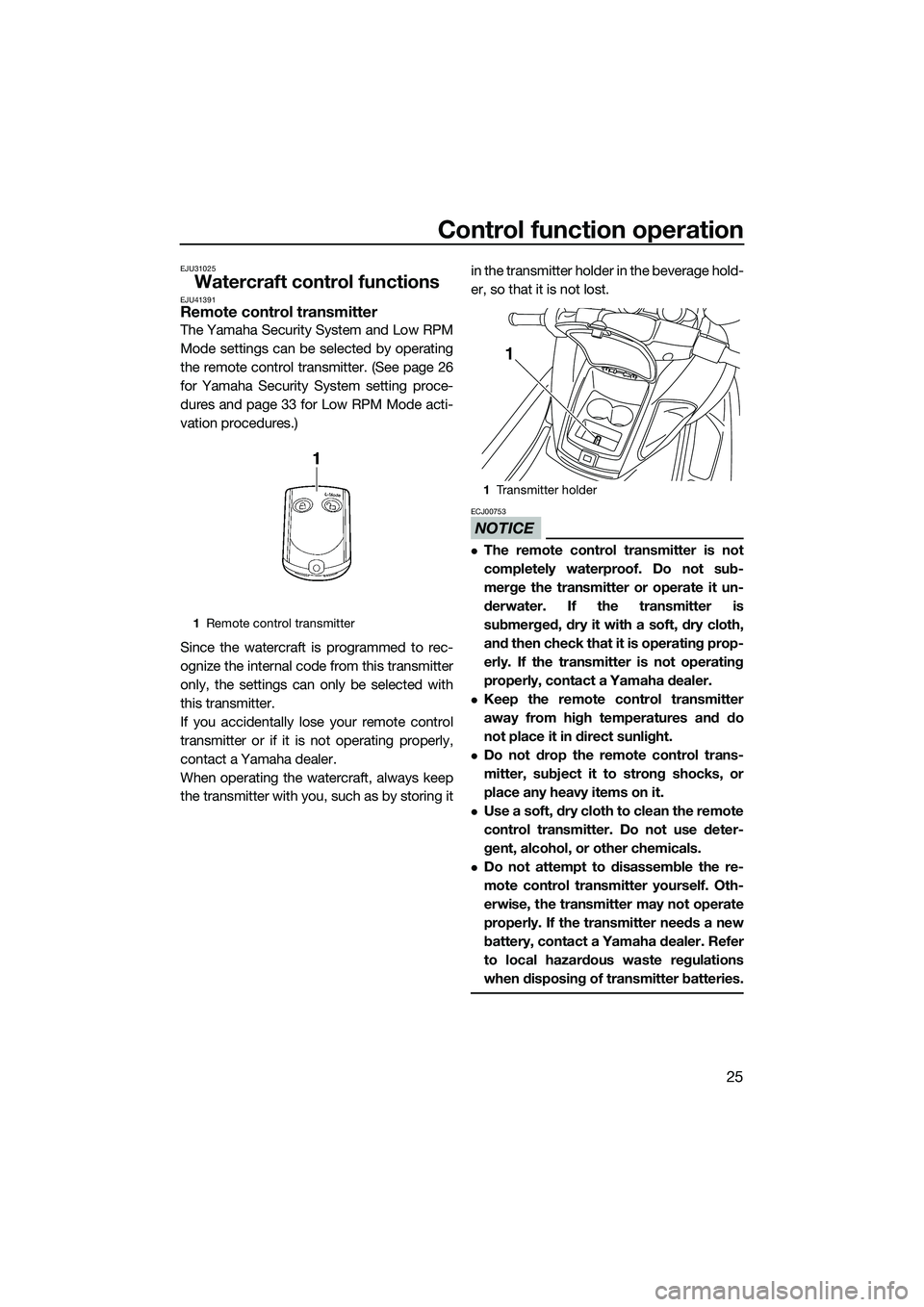
Control function operation
25
EJU31025
Watercraft control functionsEJU41391Remote control transmitter
The Yamaha Security System and Low RPM
Mode settings can be selected by operating
the remote control transmitter. (See page 26
for Yamaha Security System setting proce-
dures and page 33 for Low RPM Mode acti-
vation procedures.)
Since the watercraft is programmed to rec-
ognize the internal code from this transmitter
only, the settings can only be selected with
this transmitter.
If you accidentally lose your remote control
transmitter or if it is not operating properly,
contact a Yamaha dealer.
When operating the watercraft, always keep
the transmitter with you, such as by storing itin the transmitter holder in the beverage hold-
er, so that it is not lost.
NOTICE
ECJ00753
The remote control transmitter is not
completely waterproof. Do not sub-
merge the transmitter or operate it un-
derwater. If the transmitter is
submerged, dry it with a soft, dry cloth,
and then check that it is operating prop-
erly. If the transmitter is not operating
properly, contact a Yamaha dealer.
Keep the remote control transmitter
away from high temperatures and do
not place it in direct sunlight.
Do not drop the remote control trans-
mitter, subject it to strong shocks, or
place any heavy items on it.
Use a soft, dry cloth to clean the remote
control transmitter. Do not use deter-
gent, alcohol, or other chemicals.
Do not attempt to disassemble the re-
mote control transmitter yourself. Oth-
erwise, the transmitter may not operate
properly. If the transmitter needs a new
battery, contact a Yamaha dealer. Refer
to local hazardous waste regulations
when disposing of transmitter batteries.
1
Remote control transmitter
1Transmitter holder
1
UF3L70E0.book Page 25 Thursday, November 7, 2013 9:08 AM
Page 32 of 106
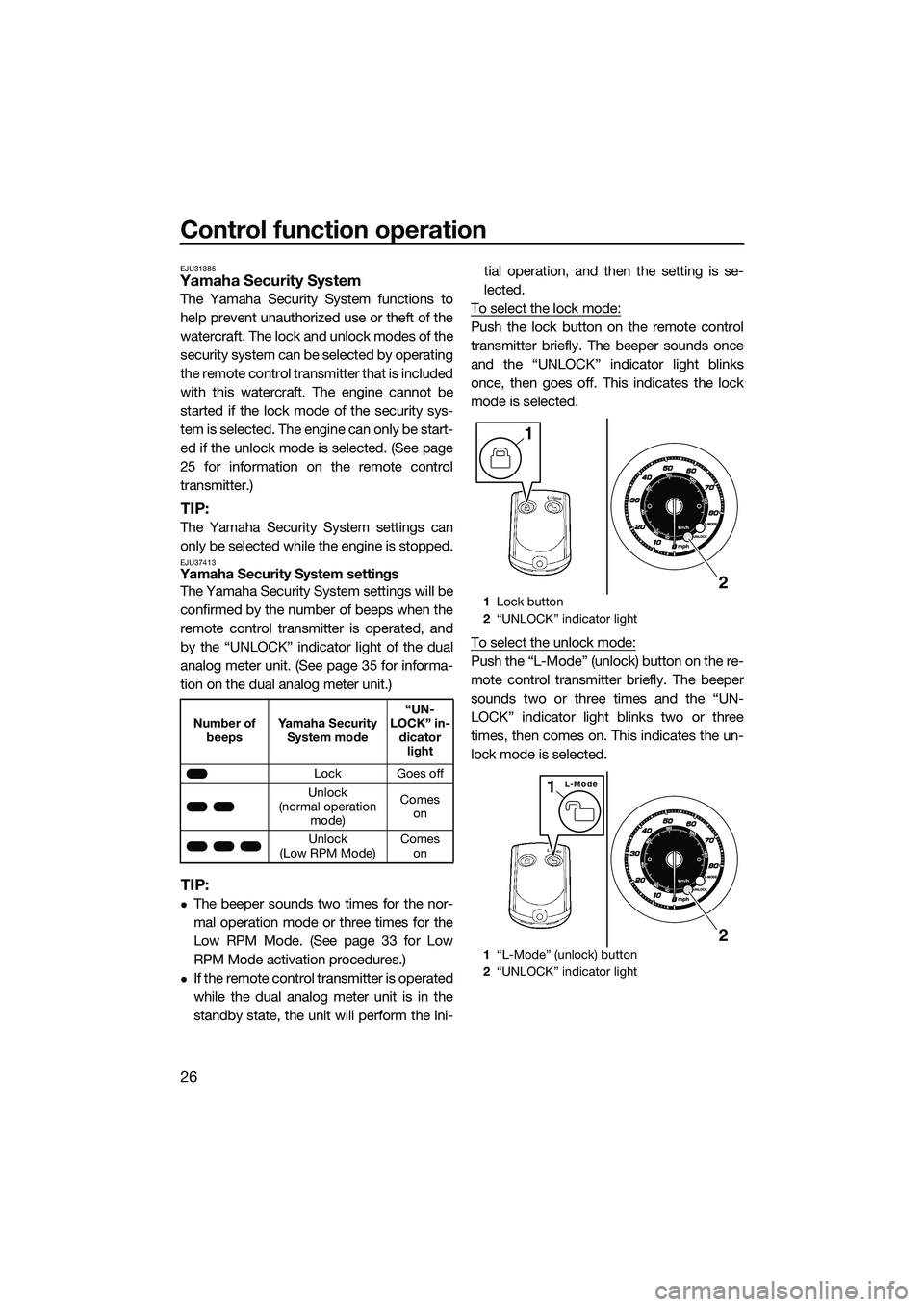
Control function operation
26
EJU31385Yamaha Security System
The Yamaha Security System functions to
help prevent unauthorized use or theft of the
watercraft. The lock and unlock modes of the
security system can be selected by operating
the remote control transmitter that is included
with this watercraft. The engine cannot be
started if the lock mode of the security sys-
tem is selected. The engine can only be start-
ed if the unlock mode is selected. (See page
25 for information on the remote control
transmitter.)
TIP:
The Yamaha Security System settings can
only be selected while the engine is stopped.
EJU37413Yamaha Security System settingsThe Yamaha Security System settings will be
confirmed by the number of beeps when the
remote control transmitter is operated, and
by the “UNLOCK” indicator light of the dual
analog meter unit. (See page 35 for informa-
tion on the dual analog meter unit.)
TIP:
The beeper sounds two times for the nor-
mal operation mode or three times for the
Low RPM Mode. (See page 33 for Low
RPM Mode activation procedures.)
If the remote control transmitter is operated
while the dual analog meter unit is in the
standby state, the unit will perform the ini- tial operation, and then the setting is se-
lected.
To select the lock mode:
Push the lock button on the remote control
transmitter briefly. The beeper sounds once
and the “UNLOCK” indicator light blinks
once, then goes off. This indicates the lock
mode is selected.
To select the unlock mode:
Push the “L-Mode” (unlock) button on the re-
mote control transmitter briefly. The beeper
sounds two or three times and the “UN-
LOCK” indicator light blinks two or three
times, then comes on. This indicates the un-
lock mode is selected.
Number of beeps Yamaha Security
System mode “UN-
LOCK” in- dicator light
Lock Goes off
Unlock
(normal operation mode) Comes
on
Unlock
(Low RPM Mode) Comes
on
1 Lock button
2 “UNLOCK” indicator light
1 “L-Mode” (unlock) button
2 “UNLOCK” indicator light
1
2
L-Mode1
2
UF3L70E0.book Page 26 Thursday, November 7, 2013 9:08 AM
Page 33 of 106
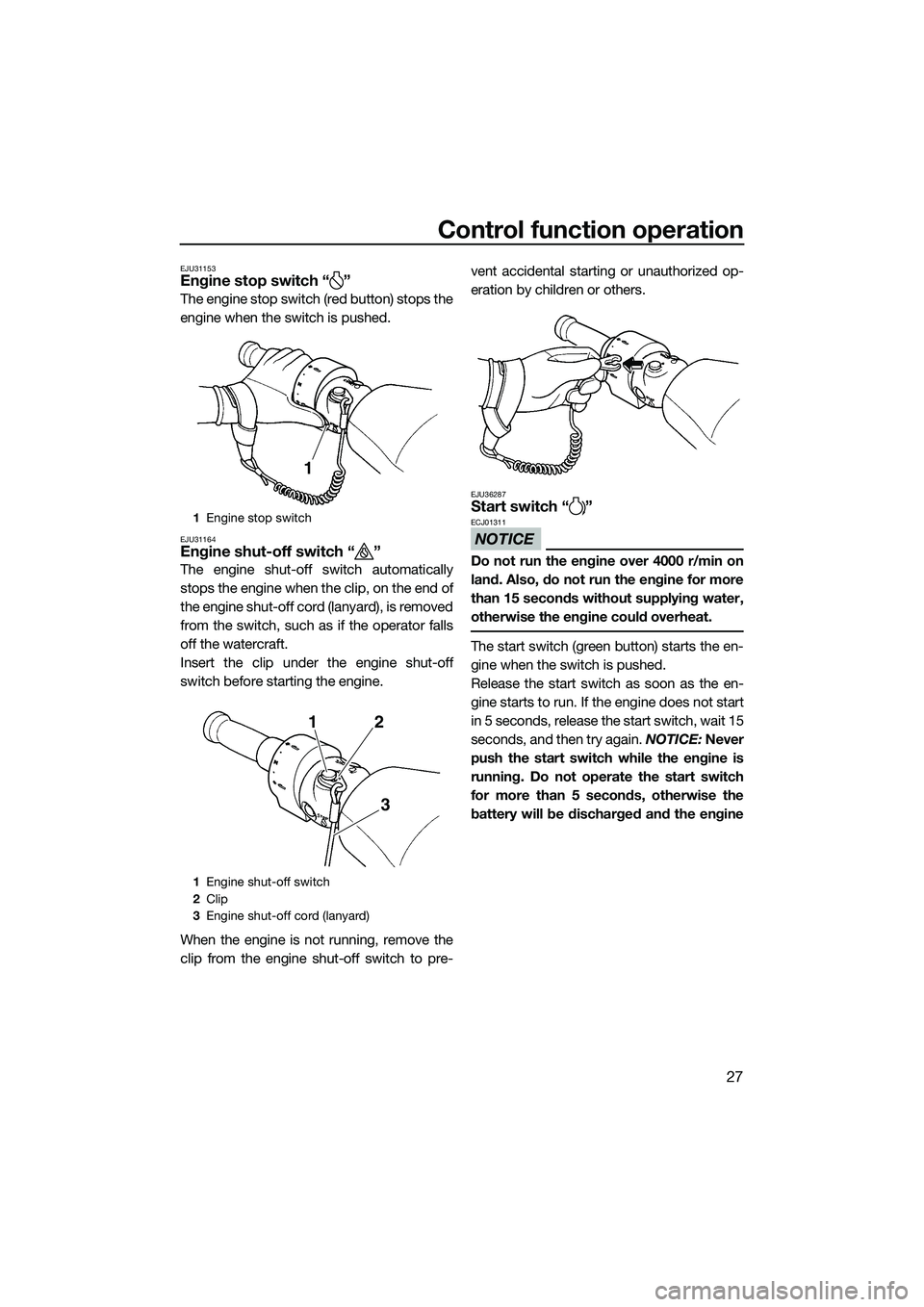
Control function operation
27
EJU31153Engine stop switch “ ”
The engine stop switch (red button) stops the
engine when the switch is pushed.
EJU31164Engine shut-off switch “ ”
The engine shut-off switch automatically
stops the engine when the clip, on the end of
the engine shut-off cord (lanyard), is removed
from the switch, such as if the operator falls
off the watercraft.
Insert the clip under the engine shut-off
switch before starting the engine.
When the engine is not running, remove the
clip from the engine shut-off switch to pre-vent accidental starting or unauthorized op-
eration by children or others.
EJU36287Start switch “ ”
NOTICE
ECJ01311
Do not run the engine over 4000 r/min on
land. Also, do not run the engine for more
than 15 seconds without supplying water,
otherwise the engine could overheat.
The start switch (green button) starts the en-
gine when the switch is pushed.
Release the start switch as soon as the en-
gine starts to run. If the engine does not start
in 5 seconds, release the start switch, wait 15
seconds, and then try again.
NOTICE: Never
push the start switch while the engine is
running. Do not operate the start switch
for more than 5 seconds, otherwise the
battery will be discharged and the engine
1 Engine stop switch
1 Engine shut-off switch
2 Clip
3 Engine shut-off cord (lanyard)
1
2
1
3
UF3L70E0.book Page 27 Thursday, November 7, 2013 9:08 AM
Page 34 of 106
![YAMAHA FZR SVHO 2014 Owners Guide Control function operation
28
will not start. Also, the starter motor could
be damaged.
[ECJ01041]
The engine will not start under any of the fol-
lowing conditions:
Lock mode of the Yamaha Securi YAMAHA FZR SVHO 2014 Owners Guide Control function operation
28
will not start. Also, the starter motor could
be damaged.
[ECJ01041]
The engine will not start under any of the fol-
lowing conditions:
Lock mode of the Yamaha Securi](/img/51/50183/w960_50183-33.png)
Control function operation
28
will not start. Also, the starter motor could
be damaged.
[ECJ01041]
The engine will not start under any of the fol-
lowing conditions:
Lock mode of the Yamaha Security System
has been selected. (See page 26 for
Yamaha Security System setting proce- dures.)
Clip is removed from the engine shut-off
switch.
Throttle lever is squeezed.EJU31212Throttle lever
The throttle lever increases the engine speed
when the lever is squeezed.
The throttle lever returns automatically to its
fully closed (idle) position when released.
EJU31262Steering system
By turning the handlebars in the direction you
wish to travel, the angle of the jet thrust noz-
zle is changed, and the direction of the water-
craft is changed accordingly.
Since the strength of the jet thrust determines
the speed and degree of a turn, throttle must
always be applied when attempting a turn,
except at trolling speed.
This model is equipped with the Yamaha En-
gine Management System (YEMS) that in-
cludes an off-throttle steering (OTS) system.
It will activate at planing speeds should you
attempt to steer the watercraft after releasing
the throttle lever. The OTS system assists in
turning by continuing to supply some thrust
while the watercraft is decelerating, but you
can turn more sharply if you apply throttle
while turning the handlebars. The OTS sys-
tem does not function below planing speeds
or when the engine is off. Once the engine
slows down, the watercraft will no longer turn
1 Start switch
1 Throttle lever
1
1
1Handlebar
2 Jet thrust nozzle
1
2
UF3L70E0.book Page 28 Thursday, November 7, 2013 9:08 AM
Page 35 of 106
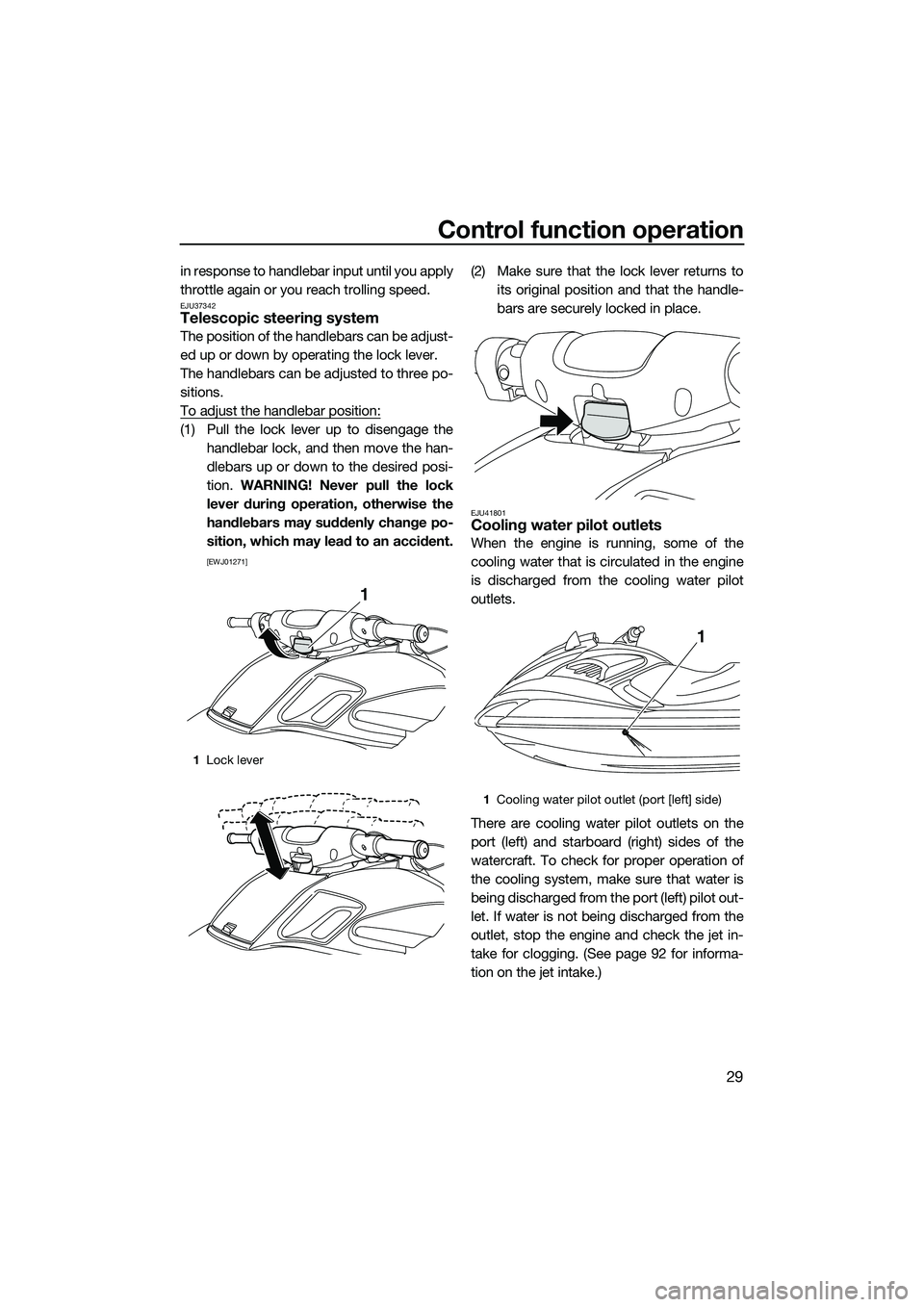
Control function operation
29
in response to handlebar input until you apply
throttle again or you reach trolling speed.
EJU37342Telescopic steering system
The position of the handlebars can be adjust-
ed up or down by operating the lock lever.
The handlebars can be adjusted to three po-
sitions.
To adjust the handlebar position:
(1) Pull the lock lever up to disengage thehandlebar lock, and then move the han-
dlebars up or down to the desired posi-
tion. WARNING! Never pull the lock
lever during operation, otherwise the
handlebars may suddenly change po-
sition, which may lead to an accident.
[EWJ01271]
(2) Make sure that the lock lever returns to its original position and that the handle-
bars are securely locked in place.
EJU41801Cooling water pilot outlets
When the engine is running, some of the
cooling water that is circulated in the engine
is discharged from the cooling water pilot
outlets.
There are cooling water pilot outlets on the
port (left) and starboard (right) sides of the
watercraft. To check for proper operation of
the cooling system, make sure that water is
being discharged from the port (left) pilot out-
let. If water is not being discharged from the
outlet, stop the engine and check the jet in-
take for clogging. (See page 92 for informa-
tion on the jet intake.)
1Lock lever
1
1Cooling water pilot outlet (port [left] side)
1
UF3L70E0.book Page 29 Thursday, November 7, 2013 9:08 AM
Page 36 of 106
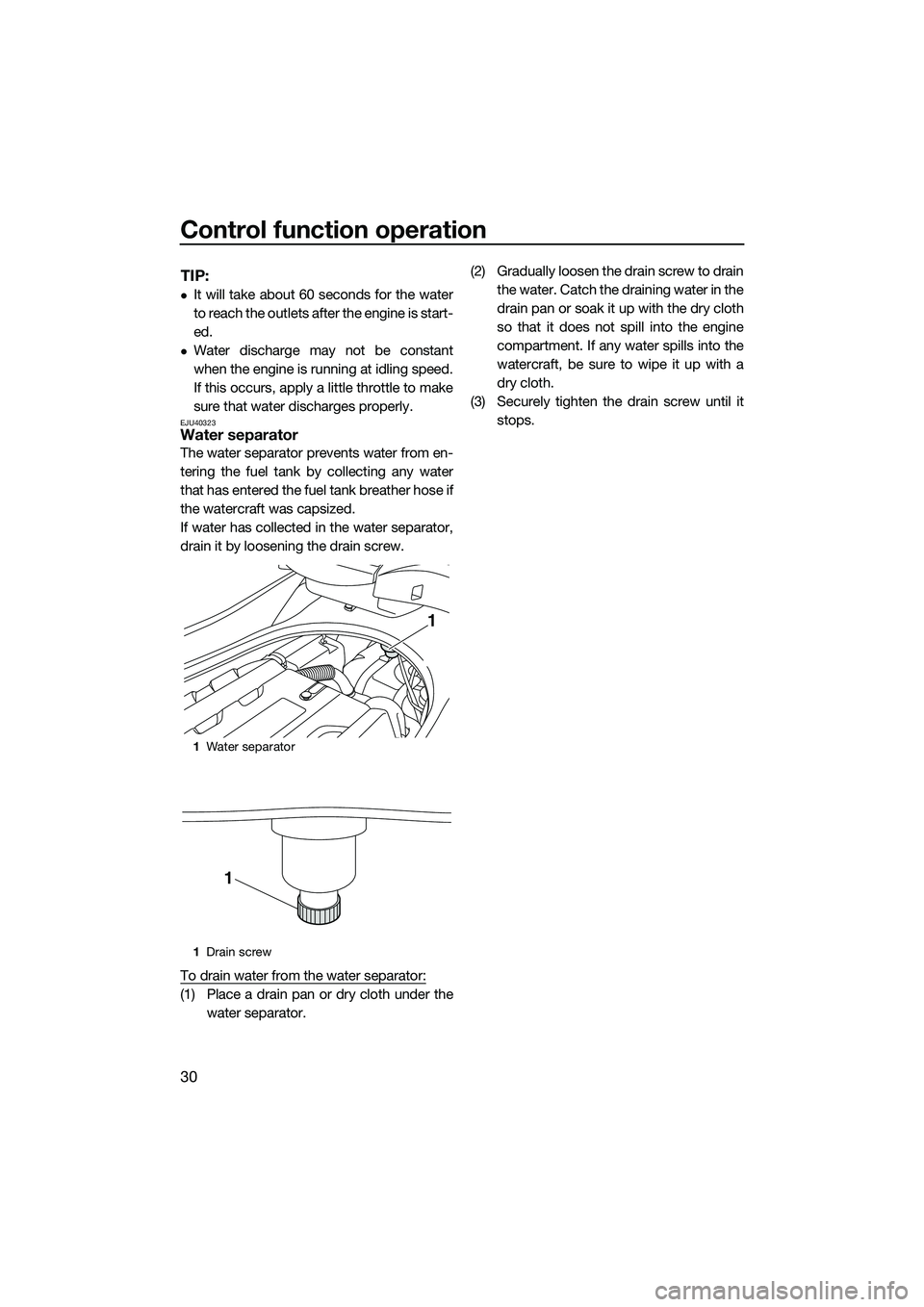
Control function operation
30
TIP:
It will take about 60 seconds for the water
to reach the outlets after the engine is start-
ed.
Water discharge may not be constant
when the engine is running at idling speed.
If this occurs, apply a little throttle to make
sure that water discharges properly.
EJU40323Water separator
The water separator prevents water from en-
tering the fuel tank by collecting any water
that has entered the fuel tank breather hose if
the watercraft was capsized.
If water has collected in the water separator,
drain it by loosening the drain screw.
To drain water from the water separator:
(1) Place a drain pan or dry cloth under thewater separator. (2) Gradually loosen the drain screw to drain
the water. Catch the draining water in the
drain pan or soak it up with the dry cloth
so that it does not spill into the engine
compartment. If any water spills into the
watercraft, be sure to wipe it up with a
dry cloth.
(3) Securely tighten the drain screw until it stops.
1Water separator
1 Drain screw
1
1
UF3L70E0.book Page 30 Thursday, November 7, 2013 9:08 AM
Page 37 of 106
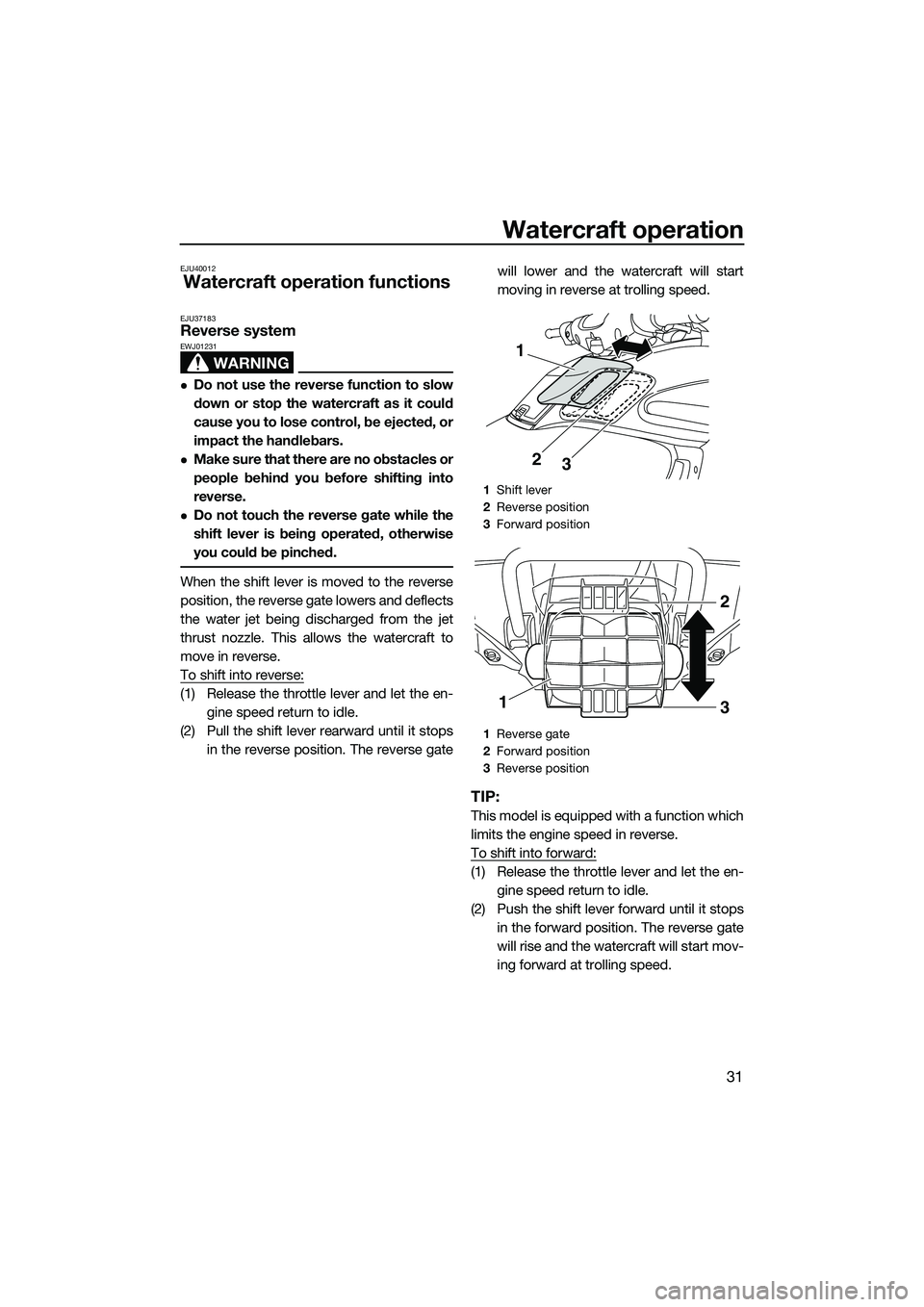
Watercraft operation
31
EJU40012
Watercraft operation functions
EJU37183Reverse system
WARNING
EWJ01231
Do not use the reverse function to slow
down or stop the watercraft as it could
cause you to lose control, be ejected, or
impact the handlebars.
Make sure that there are no obstacles or
people behind you before shifting into
reverse.
Do not touch the reverse gate while the
shift lever is being operated, otherwise
you could be pinched.
When the shift lever is moved to the reverse
position, the reverse gate lowers and deflects
the water jet being discharged from the jet
thrust nozzle. This allows the watercraft to
move in reverse.
To shift into reverse:
(1) Release the throttle lever and let the en-gine speed return to idle.
(2) Pull the shift lever rearward until it stops in the reverse position. The reverse gate will lower and the watercraft will start
moving in reverse at trolling speed.
TIP:
This model is equipped with a function which
limits the engine speed in reverse.
To shift into forward:
(1) Release the throttle lever and let the en-
gine speed return to idle.
(2) Push the shift lever forward until it stops in the forward position. The reverse gate
will rise and the watercraft will start mov-
ing forward at trolling speed.
1Shift lever
2 Reverse position
3 Forward position
1 Reverse gate
2 Forward position
3 Reverse position
3
2
1
1
2
3
UF3L70E0.book Page 31 Thursday, November 7, 2013 9:08 AM
Page 38 of 106
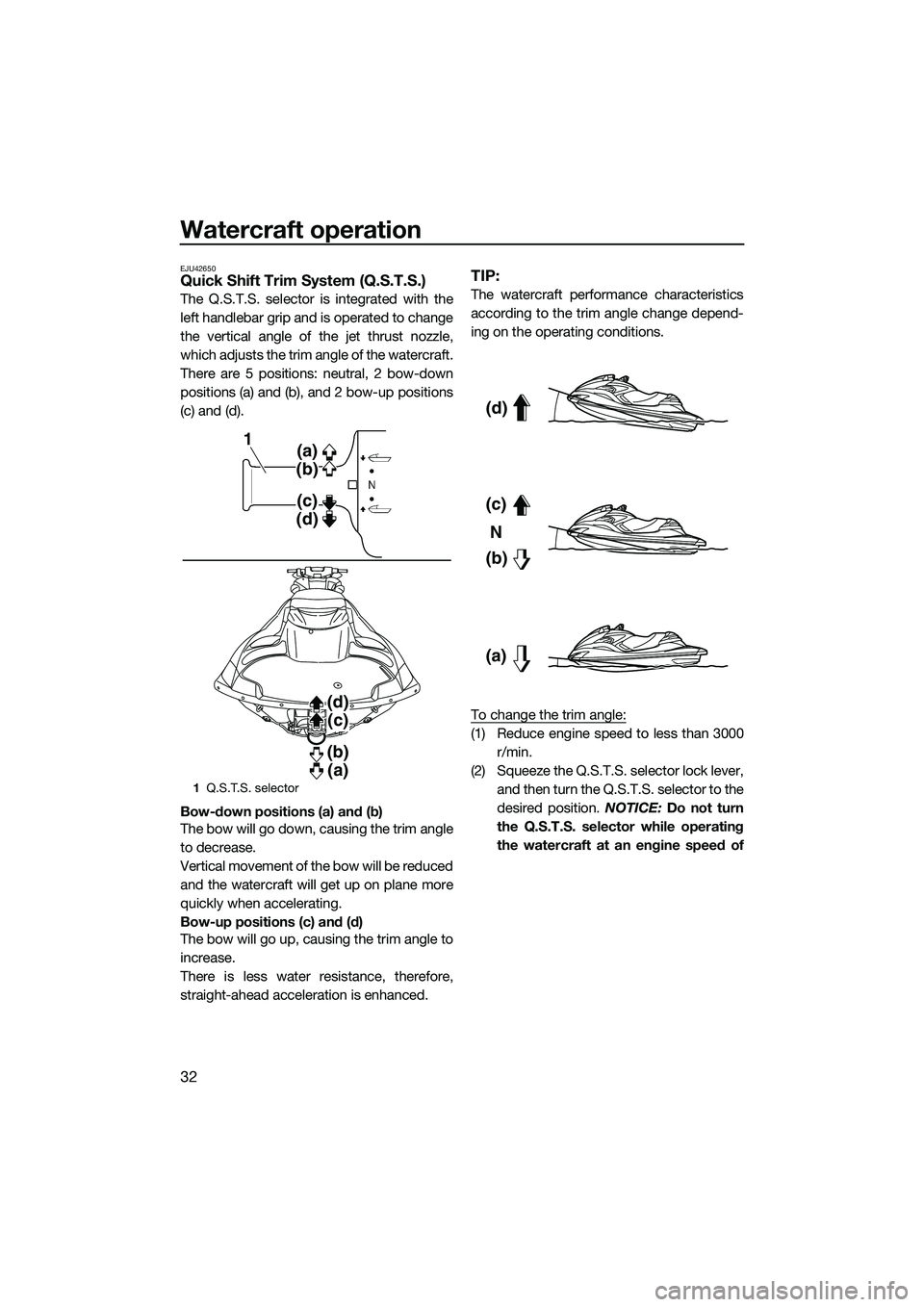
Watercraft operation
32
EJU42650Quick Shift Trim System (Q.S.T.S.)
The Q.S.T.S. selector is integrated with the
left handlebar grip and is operated to change
the vertical angle of the jet thrust nozzle,
which adjusts the trim angle of the watercraft.
There are 5 positions: neutral, 2 bow-down
positions (a) and (b), and 2 bow-up positions
(c) and (d).
Bow-down positions (a) and (b)
The bow will go down, causing the trim angle
to decrease.
Vertical movement of the bow will be reduced
and the watercraft will get up on plane more
quickly when accelerating.
Bow-up positions (c) and (d)
The bow will go up, causing the trim angle to
increase.
There is less water resistance, therefore,
straight-ahead acceleration is enhanced.
TIP:
The watercraft performance characteristics
according to the trim angle change depend-
ing on the operating conditions.
To change the trim angle:
(1) Reduce engine speed to less than 3000r/min.
(2) Squeeze the Q.S.T.S. selector lock lever, and then turn the Q.S.T.S. selector to the
desired position. NOTICE: Do not turn
the Q.S.T.S. selector while operating
the watercraft at an engine speed of
1 Q.S.T.S. selector
(c)
(d) (a)
(b)
(b) (a)
(d)
(c)
1
(d)
(c)
(b) N
(a)
UF3L70E0.book Page 32 Thursday, November 7, 2013 9:08 AM
Page 39 of 106
![YAMAHA FZR SVHO 2014 Owners Guide Watercraft operation
33
3000 r/min or more, otherwise dam-
age could occur to the Q.S.T.S.
[ECJ00014]
(3) Release the lock lever, and then makesure that the Q.S.T.S. selector is securely
locked in pl YAMAHA FZR SVHO 2014 Owners Guide Watercraft operation
33
3000 r/min or more, otherwise dam-
age could occur to the Q.S.T.S.
[ECJ00014]
(3) Release the lock lever, and then makesure that the Q.S.T.S. selector is securely
locked in pl](/img/51/50183/w960_50183-38.png)
Watercraft operation
33
3000 r/min or more, otherwise dam-
age could occur to the Q.S.T.S.
[ECJ00014]
(3) Release the lock lever, and then makesure that the Q.S.T.S. selector is securely
locked in place.
EJU40001
Watercraft operation modes
EJU42760Low RPM Mode
The Low RPM Mode is a function that limits
the maximum engine speed to approximately
60% of the maximum engine speed in the
normal mode.
The Low RPM Mode can only be activated
and deactivated by operating the remote
control transmitter that is included with this
watercraft. (See page 25 for information on
the remote control transmitter.)
TIP:
The Low RPM Mode can only be activated
when the engine is stopped in the unlock
mode of the Yamaha Security System.
Activating and deactivating the Low RPM
Mode
Activation of the Low RPM Mode will be con-
firmed by the number of beeps when the re-
mote control transmitter is operated, and by
the “L-MODE” indicator light of the dual ana-
log meter unit. (See page 35 for information
on the dual analog meter unit.)
1Q.S.T.S. selector
2 Q.S.T.S. selector lock lever
1Remote control transmitter
UF3L70E0.book Page 33 Thursday, November 7, 2013 9:08 AM
Page 40 of 106
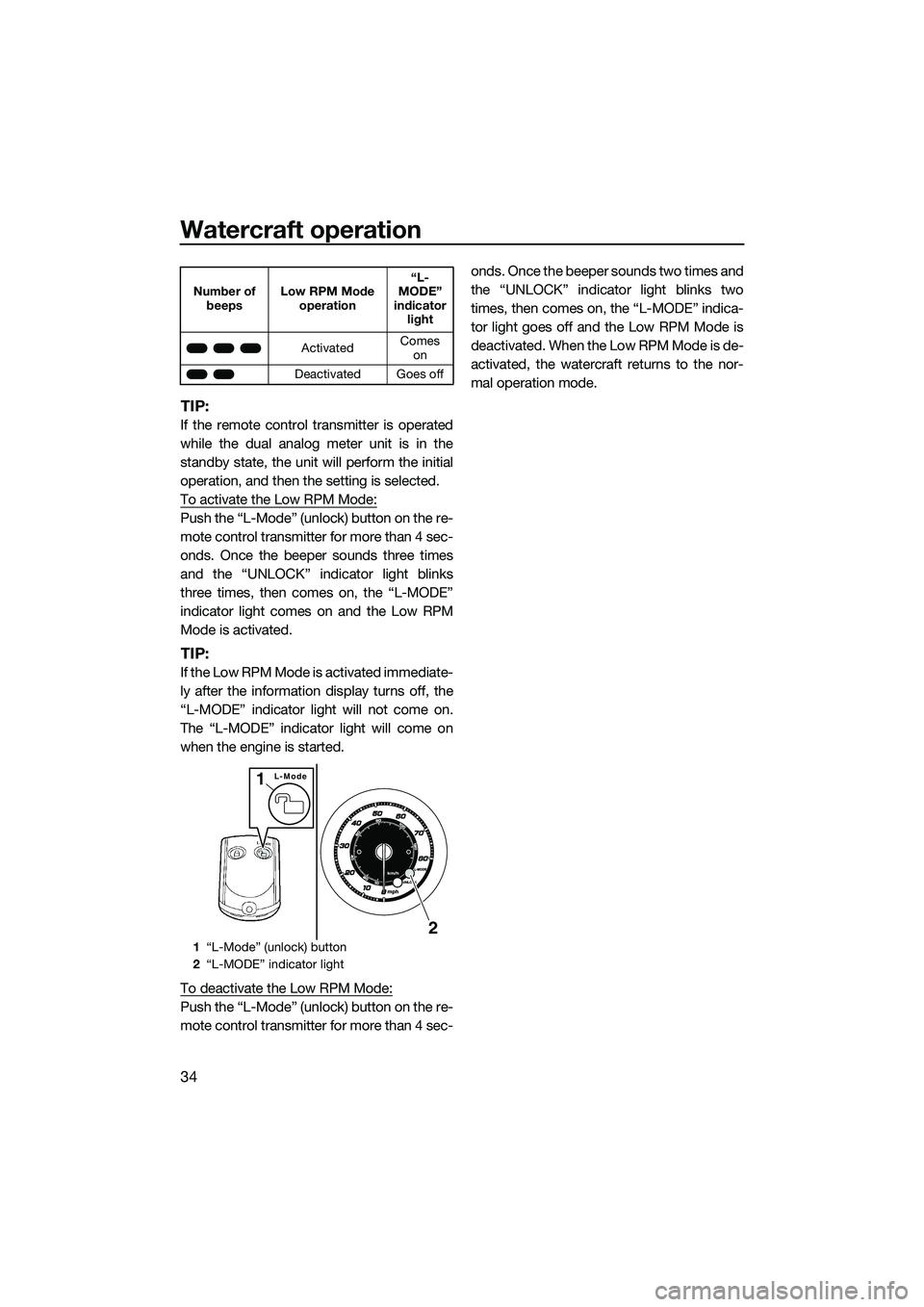
Watercraft operation
34
TIP:
If the remote control transmitter is operated
while the dual analog meter unit is in the
standby state, the unit will perform the initial
operation, and then the setting is selected.
To activate the Low RPM Mode:
Push the “L-Mode” (unlock) button on the re-
mote control transmitter for more than 4 sec-
onds. Once the beeper sounds three times
and the “UNLOCK” indicator light blinks
three times, then comes on, the “L-MODE”
indicator light comes on and the Low RPM
Mode is activated.
TIP:
If the Low RPM Mode is activated immediate-
ly after the information display turns off, the
“L-MODE” indicator light will not come on.
The “L-MODE” indicator light will come on
when the engine is started.
To deactivate the Low RPM Mode:
Push the “L-Mode” (unlock) button on the re-
mote control transmitter for more than 4 sec-onds. Once the beeper sounds two times and
the “UNLOCK” indicator light blinks two
times, then comes on, the “L-MODE” indica-
tor light goes off and the Low RPM Mode is
deactivated. When the Low RPM Mode is de-
activated, the watercraft returns to the nor-
mal operation mode.
Number of
beeps Low RPM Mode
operation “L-
MODE”
indicator light
Activated Comes
on
Deactivated Goes off
1 “L-Mode” (unlock) button
2 “L-MODE” indicator light
L-Mode1
2
UF3L70E0.book Page 34 Thursday, November 7, 2013 9:08 AM